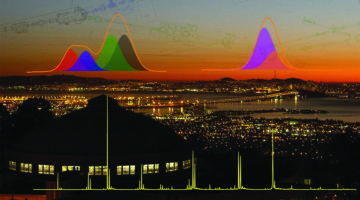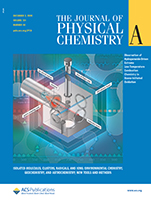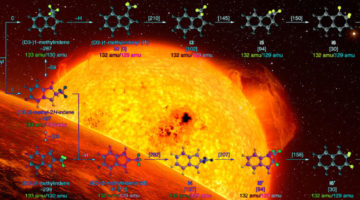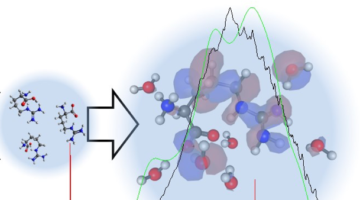The Chemical Dynamics beamline, used for gas-phase vacuum ultraviolet (VUV) experiments, was one of the first beamlines built at the ALS. Since then, the program has undergone several strategic transformations, enabling the study of complexity in clusters, aerosols, and nanoparticles using both VUV and soft x-ray radiation. Read more »
Key to Cleaner Combustion? Look to the Stars
Researchers made the first real-time, lab-based measurement of free radicals reacting under cosmic conditions, prompting elementary carbon and hydrogen atoms to coalesce into primal benzene rings. The findings are key to understanding how the universe evolved with the growth of carbon compounds and could also help the car industry make cleaner combustion engines. Read more »
Gas-phase synthesis of corannulene—a molecular building block of fullerenes
Fullerenes have been implicated to play a key role in the astrochemical evolution of the interstellar medium. However, the formation mechanism of even their simplest molecular building block—corannulene—has remained elusive. Here we demonstrate that corannulene can be synthesized in the gas phase through reactions mimicking conditions in carbon-rich circumstellar envelopes. Read more »
Extreme Low-Temperature Combustion Chemistry: Ozone-Initiated Oxidation of Methyl Hexanoate
The accelerating effect of ozone on the oxidation of methyl hexanoate was probed with time-of-flight mass spectrometry. A new oxidation regime was observed at temperatures below the well-known low-temperature chemistry regime. The results indicate that the chemistry in this regime is initiated by thermal ozone dissociation and subsequent H abstraction from methyl hexanoate by O atoms. Read more »
Criegee Intermediates Play Unexpected Role in Cell Chemistry
Researchers employed mass spectrometry to illuminate lipid nanodroplets under ultraviolet light. The results unexpectedly showed that hydroxyl radicals cause damage to cells via the formation of Criegee intermediates: molecules first proposed in 1975 to explain how pollutants react with the ozone layer in our atmosphere. Read more »
Scientists Discover New Clue Behind Age-Related Diseases and Food Spoilage
Scientists at Berkeley Lab have made a surprising discovery that could help explain our risk for developing chronic diseases or cancers as we get older, and how our food decomposes over time. The findings point to an unexpected link between the ozone chemistry in our atmosphere and our cells’ hardwired ability to ward off disease. Read more »
Study Reveals ‘Radical’ Wrinkle in Forming Complex Carbon Molecules in Space
Scientists have identified several avenues by which ringed molecules known as polycyclic aromatic hydrocarbons can form in space. PAHs—which also occur on Earth in emissions and soot from the combustion of fossil fuels—could provide clues to the formation of life’s chemistry in space as precursors to interstellar nanoparticles. Read more »
Fundamental Property of Arginine Revealed Through Solvation
Just 20 amino acids act as building blocks for all our proteins, but their chemical properties have been difficult to study at the most fundamental level. Combining experiments and theory at the ALS, researchers have now determined the ionization energy of arginine, an amino acid with over 100 isomers. Read more »
Peroxy self-reaction leading to the formation of furfural
Furan and its alkyl derivatives, such as methylfuran (2MF), have been identified as valid alternative biofuels. This study focuses on the self-reaction of the peroxy radical generated in the first oxidation step of 2MF. The mass spectrometry data reveal that furfural is the dominant product of 2MF oxidation. Various reaction mechanisms for furfural formation are proposed here. Read more »
Gas‐Phase Synthesis of Triphenylene (C18H12)
The cover image shows the triphenylene molecule as a potential precursor to two‐dimensional graphite nanosheets in the interstellar medium. The barrier‐less, exoergic nature of the reaction reveals a versatile reaction mechanism that may drive molecular mass growth processes in cold environments in deep space. Read more »









